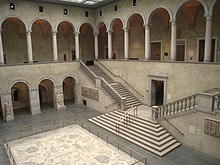Worcester Art Museum
 |
|
| Established | 1898 |
|---|---|
| Location | 55 Salisbury Street Worcester, Massachusetts |
| Coordinates | 42°16′23″N 71°48′07″W / 42.273007°N 71.802029°W |
| Type | Art museum |
| Director | Matthias Waschek |
| Architect | Stephen C. Earle |
| Public transit access |
MBTA
Worcester |
| Website | www |
The Worcester Art Museum, also known by its acronym WAM, houses over 35,000 works of art dating from antiquity to the present day, representing cultures from all over the world. The WAM opened in 1898 in Worcester, Massachusetts, and is the second largest art museum in New England. The WAM also has a café, museum shop, library, and a year-round roster of classes for children and adults.
In September 1896, Stephen Salisbury III and a group of his friends gathered together to create the Art Museum Corporation. Salisbury then gave a tract of land, on what was once the Salisbury farm (now fronting Salisbury Street in Worcester, Massachusetts), as well as $100,000 USD to build an art museum. The museum was designed by Stephen C. Earle, a Worcester architect, and formally opened in 1898 with the Rev. Daniel Merriman as its first president. The museum's collection by largely of plaster casts of "antique and Renaissance" sculptures as well as a selection of 5,000 Japanese prints, drawings, and books, willed to the museum from John Chandler Bancroft, son of John Bancroft.
In 1905, Stephen Salisbury died and left the bulk of his five million-dollar estate to the museum.
The Worcester Art Museum continued to grow and slowly gathered a world-class art collection, with some of the important early works donated or loaned by the artist anc collector Helen Bigelow Merriman. The WAM became the first museum in the United States to purchase works by Claude Monet as well as Paul Gauguin. The museum was also the first institution to transport a medieval building, a chapter house, from Europe and install it in America.
Between 1932 and 1939, the Worcester Art Museum joined a consortium of museums and institutions to sponsor expeditions to the archaeological sites where the city of Antioch once stood. This group of museums, including Princeton University, the Musée du Louvre, the Baltimore Museum of Art, and Harvard University's affiliate, Dumbarton Oaks, discovered hundreds of intricate floor mosaics. The Antioch mosaics, as they are now known, were split up among the institutions The WAM received many mosaics including the Worcester Hunt, which is now installed in the Renaissance Court's floor.
...
Wikipedia
